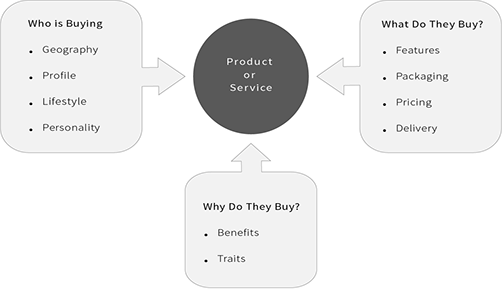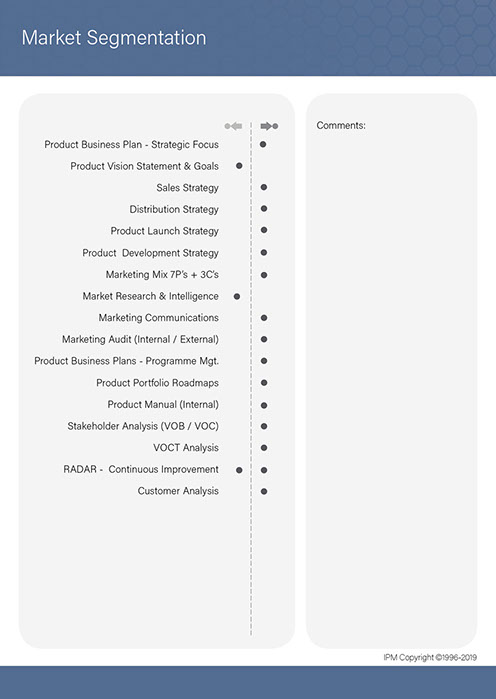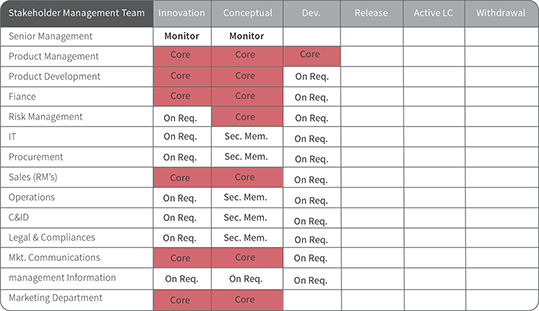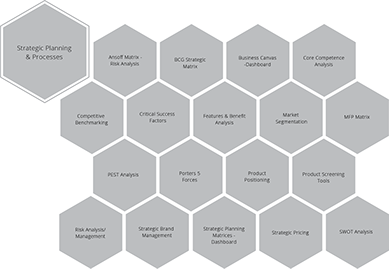Glossary
Logout
©Copyright Arcturus 2022, All Rights Reserved.
7
Terms & Conditions
|
|
|
|
Security & Privacy
Contact
MARKET SEGMENTATION
|Introduction
Market segmentation is defined as the process of dividing the consumer market into meaningful buyer groups and then creating specific marketing programs for one or more of the resulting segments with a view to achieving financial and other corporate objectives. It represents a middle way between a strategy of market aggregation, in which all consumers are treated similarly, and one of total market desegregation, in which each consumer is treated uniquely.
The concept of segmentation is based on the propositions that (1) consumers are different; (2) differences in consumers are related to differences in market behaviour; and (3) segments of consumers can be isolated within the overall market. The benefits that may result from a segmentation approach include:
- A more precise definition of the market in terms of the needs of specific groups, why they behave as they do, and possible ways of influencing behaviour;
- Improved ability to identify competitive strengths and weaknesses, and opportunities for winning specific segments from the competition;
- More efficient allocation of limited resources to develop programs which can best satisfy the needs of target segments;
- Clarification of objectives and definition of performance standards.
The objective is to select segmentation variables that are likely to prove useful in a specific operational context. It can be argued that each of the following three criteria must be satisfied if meaningful market segments are to be developed:
- It must be possible to obtain information on the specific characteristics of interest.
- Management must be able to identify chosen segments within the overall market and
efficiently focus marketing efforts on these segments.
3. The segments must be large enough (and/or sufficiently important to the organisation) to
merit the time and cost of separate attention.
The overall market for any given product can generally be segmented along several different dimensions. Thus, one can segment the market:
- Geographically (according to where consumers live or where they purchase and use the product);
- By demographic characteristics of consumers (sex, age, income levels, stage in the family life‐cycle, education level, occupation, etc.);
- By consumption volume or size of unit purchase;
- By the different uses to which the product is put;
- According to what are termed psycho-graphics (variations in consumers’ needs resulting from lifestyle or personality characteristics);
- By product attributes (such as size, price range, portability, technical features, etc).
It is often useful to segment a market along two or more dimensions at once, but concurrent use of multiple methods of segmentation may lead to an unmanageable and meaningless number of market segments. The same consumer may fall into different segments in different marketing situations. For one product category, the most important variable may be the consumer’s age, while for others, it may be income level, the purpose for which he or she buys the product, or the type of retail outlet selected.
|Benefits of Segmentation
Helps reduce risk in the market place in two ways:
- Provides a profile of target consumers, so that marketing strategies can be “customised” for maximum impact.
- Aids planning by helping to identify “open” segments and potential market opportunities.
|Basic Assumption
Because consumers’ behaviour is generally not random, it is possible to identify groups of individuals within the total market who demand different kinds of product characteristics and react differently to marketing actions.
|Basic Assumption
Consumers within each segment are more similar to each other in characteristics and behaviour than they are to consumers in other segments.
- There are measurable factors by which individuals can be “placed” within a particular segment.
- Each segment can be reached by particular advertising media and distribution channels.
- Each segment has effective demand. It is large enough and has sufficient purchasing power.

|Target Market Analysis
In order to apply segmentation principles we need to answer 3 primary questions.
- Who is buying the product / service?
- What do they buy?
- Why do they buy?

The answers will in turn lead to the segmentation criteria for the Product / Service.
|Dimensions of Segmentation
Who the consumer is – in terms of a specific criterion.
|Market Behaviour
What the consumer does – in terms of how they use the product, how they purchase the product etc.
|Method
Target Market
Defining your target market will help you develop plans to achieve sales objectives for an existing product / service and help you set realistic sales objectives for a new product / service.
Segmentation ~ Target Market
Segmentation as previously stated is a selection process that divides the broad consuming market into manageable segments with common characteristics enabling you to realize the greatest potential sales at the lowest cost. Develop your target market by first selecting the current and potential purchaser and/or user of your product, and second, by breaking down this broad group into the most relevant segment{s} for the most effective arid efficient communication and selling of your product.
In segmenting your target market(s) you define the ultimate purchaser(s) or user(s) of your product, who will become your primary target. Further, you also may find it necessary to define and consider secondary targets, such as a smaller but high consuming and/or very profitable segment. Other potential secondary targets might be influencers or intermediate markets.
Target Market Defining Methodology
There are various methods to determine the target market for your product / service. The following is a step‐by‐step process to define your primary and secondary business‐to‐business target markets.
Business‐To‐Business Primary Target Market
Step 1 ‐ Define Your Existing Core Markets
You should have a clear understanding of your target market and how your product is currently used – Please refer to the your business segmentation practice and new versus repeat usage. You must decide whether to focus your marketing efforts on selling more to your key primary customers or selling more products to lesser purchasing customers who have high purchasing potential. What is most efficient? What holds more short‐ and long‐term potential?
Step 2 ‐ Target High Potential New Markets
After redefining your customer target market to fully exploit its potential, next compare your target customer to the marketplace. Target companies that best match your company's volume customers in terms of size (Volume and Value potential) and segment, not neglecting application of product and organization structure (one location versus branches).
Evaluate all potential markets to check whether it could satisfy the needs and requirements of companies in the defined categories above. After reviewing market potential, you might come to a realization that only a few will become part of the primary target market and candidates for a secondary target.
Step 3 ‐ Define the Target Market Focus
Once you have segmented the target market, you must focus on the way the product is communicated to that market and how specific needs must be met. Individual strategies may be appropriate for different markets and they need to be identified as such.
Secondary Target Market
Now that you have made a primary target market determination, it is wise to consider secondary targets that you originally discarded because they did not account for the majority of sales volume or sales potential.
|Business to Business Secondary Targets
In business‐to‐business situations, a secondary target many times can be a customer who does not heavily purchase from your company currently but has high purchasing potential. You can delineate the potential of this customer by estimating your competitors' sales to this customer and determining what additional needs can fulfil for this customer.
|Who Should Attend
The following delegates / members of the Stakeholder Management Team (SMT) should attend the Market Segmentation workshop.
Key / Definition:‐
Monitor: Oversees the overall process, required to provide top level strategic objectives as required,performs a management role.
Core: Defines the ‘Core’ team headed (chaired) by the Product Manager required to attend the workshop in alignment with the ‘Product Phase’. Membership is mandatory.
Sec. Mem: Secondary Membership defines an ‘on‐standby’ membership requirement and will depend upon the subject area, phase alignment and the project status. Membership is managed by the Product Manager.
On Req.: On Request membership defines a membership that is managed by the Product Manager.
|Related Procedures
The following interrelationship maps indicate; suggested content from other models/processes which may have influence or an effect on the analysis of the title process. The left-hand column indicates information or impact from the named process and the left-hand column indicates on completion of the process/analysis it may have an influence or effect on the listed processes.
Note: A complete set (professional quality) of PMM interrelationship cards are available to purchase - please contact us for further details.

|Strategic Business Models, Workshop Tools & Professional Resources
The IPM practitioner series, is a definitive and integrated training programme for management professionals operating in the Product Management arena. So whether you’re the Managing Director, Product Director, Product Manager or a member of the Multidisciplinary Team we are confident that you will find this particular training series to be one of the best available and an invaluable asset to both you and your company.
PMM - Professional Support





































